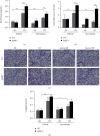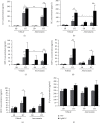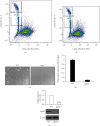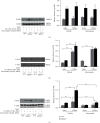Sphingosine Kinase 1 Plays an Important Role in Atorvastatin-Mediated Anti-Inflammatory Effect against Acute Lung Injury
- PMID: 34970075
- PMCID: PMC8714370
- DOI: 10.1155/2021/9247285
Sphingosine Kinase 1 Plays an Important Role in Atorvastatin-Mediated Anti-Inflammatory Effect against Acute Lung Injury
Abstract
Atorvastatin is a 3-hydroxy-3-methylglutaryl coenzyme A reductase (HMG-CoA reductase) inhibitor and inhibits cholesterol synthesis. Recently, atorvastatin also showed anti-inflammatory effect in acute lung injury, ameliorating pulmonary gas-blood exchanging function. Sphingosine kinase 1 plays a central role in endothelial (EC) cytoskeleton rearrangement and EC barrier integrity regulation. In this study, the role of sphingosine kinase 1 in atorvastatin anti-inflammatory effect against acute lung injury was investigated. Both wild-type (WT) and SphK1-/- mice were challenged with high tidal volume ventilation (40 ml/kg body weight, 65 breathing/min, 4 hours). The acute lung injury was evaluated and the mechanisms were explored. In WT mice, atorvastatin treatment significantly decreased acute lung injury responding to high tidal volume ventilation (HT), including protein, cellular infiltration, and cytokine releasing; comparing to WT mice, SphK1-/- mice showed significantly worsen pulmonary injuries on HT model. Moreover, the atorvastatin-mediated anti-inflammatory effect was diminished in SphK1-/- mice. To further confirm the role of SphK1 in VILI, we then compared the inflammatory response of endothelial cells that were isolated from WT and SphK1-/- mice to cyclic stretching. Similarly, atorvastatin significantly decreased cytokine generation from WT EC responding to cyclic stretching. Atorvastatin also significantly preserved endothelial junction integrity in WT EC against thrombin challenge. However, the inhibitory effect of atorvastatin on cytokine generation induced by cyclic stretching was abolished on SphK1-/- mice EC. The endothelial junction integrity effects of atorvastatin also diminished on SphK1-/- mouse EC. Signal analysis indicated that atorvastatin inhibited JNK activation induced by cyclic stretch. SphK1 knockout also blocked atorvastatin-mediated VE-cadherin junction enhancement. In summary, by inhibition of MAPK activity and maintenance of EC junction homeostasis, SphK1 plays a critical role in atorvastatin-mediated anti-inflammatory effects in both cellular and in vivo model. This study also offers an insight into mechanical stress-mediated acute lung injury and potential therapy in the future.
Copyright © 2021 Lan Wu et al.
Conflict of interest statement
The authors declared no potential conflicts of interest with respect to the research, authorship, and/or publication of this article.
Figures








Similar articles
-
Kaempferol mitigates sepsis-induced acute lung injury by modulating the SphK1/S1P/S1PR1/MLC2 signaling pathway to restore the integrity of the pulmonary endothelial cell barrier.Chem Biol Interact. 2024 Aug 1;398:111085. doi: 10.1016/j.cbi.2024.111085. Epub 2024 May 31. Chem Biol Interact. 2024. PMID: 38823539
-
Transient receptor potential channel 1 maintains adherens junction plasticity by suppressing sphingosine kinase 1 expression to induce endothelial hyperpermeability.FASEB J. 2016 Jan;30(1):102-10. doi: 10.1096/fj.15-275891. Epub 2015 Aug 27. FASEB J. 2016. PMID: 26316271 Free PMC article.
-
Inhibition of sphingosine kinase 1 attenuates LPS-induced acute lung injury by suppressing endothelial cell pyroptosis.Chem Biol Interact. 2024 Feb 25;390:110868. doi: 10.1016/j.cbi.2024.110868. Epub 2024 Jan 12. Chem Biol Interact. 2024. PMID: 38218310
-
Sphingolipids in pulmonary fibrosis.Adv Biol Regul. 2015 Jan;57:55-63. doi: 10.1016/j.jbior.2014.09.008. Epub 2014 Oct 13. Adv Biol Regul. 2015. PMID: 25446881 Free PMC article. Review.
-
Sphingosine kinase 1 in viral infections.Rev Med Virol. 2013 Mar;23(2):73-84. doi: 10.1002/rmv.1718. Epub 2012 May 28. Rev Med Virol. 2013. PMID: 22639116 Review.
Cited by
-
Effects of different antiplatelet therapy drugs on platelet activation and platelet-leukocyte aggregate formation in early septic ARDS.BMC Pharmacol Toxicol. 2025 Jan 6;26(1):4. doi: 10.1186/s40360-024-00806-x. BMC Pharmacol Toxicol. 2025. PMID: 39762913 Free PMC article.
-
The role of oxidative stress in aortic dissection: a potential therapeutic target.Front Cardiovasc Med. 2024 Jul 12;11:1410477. doi: 10.3389/fcvm.2024.1410477. eCollection 2024. Front Cardiovasc Med. 2024. PMID: 39070552 Free PMC article. Review.
References
MeSH terms
Substances
LinkOut - more resources
Full Text Sources
Research Materials

